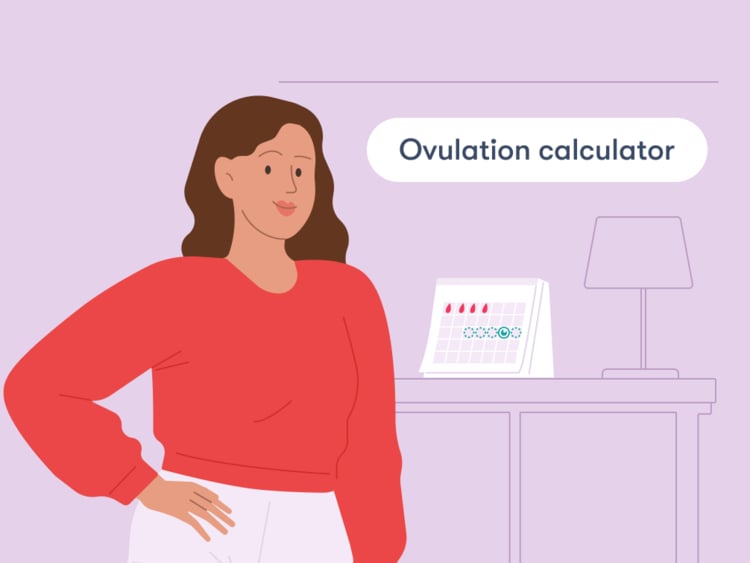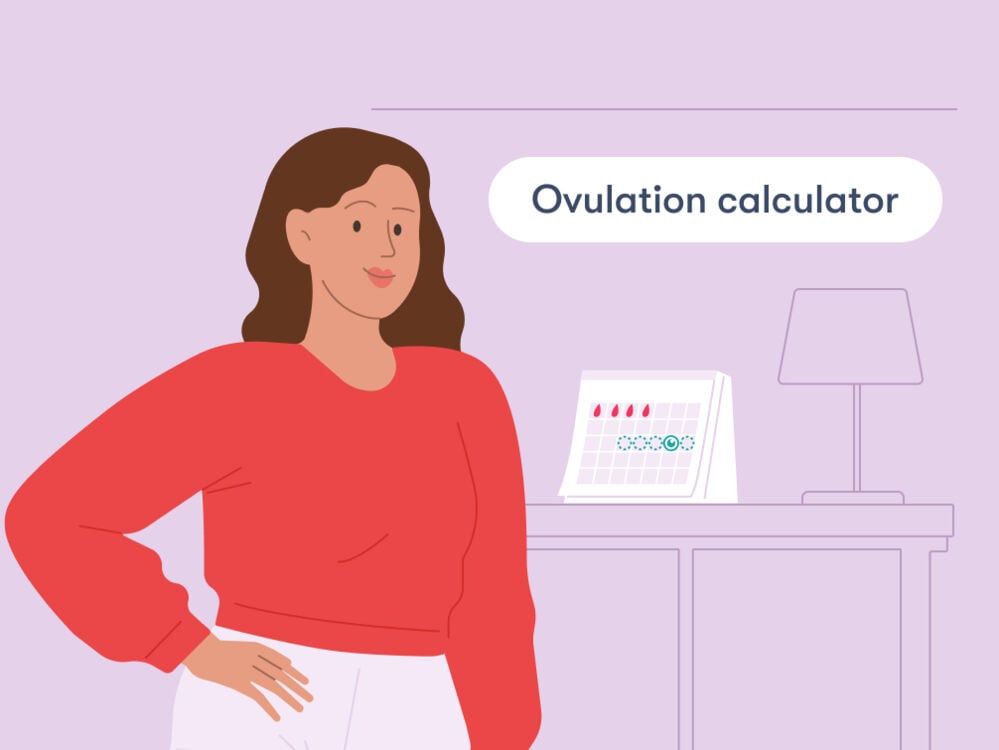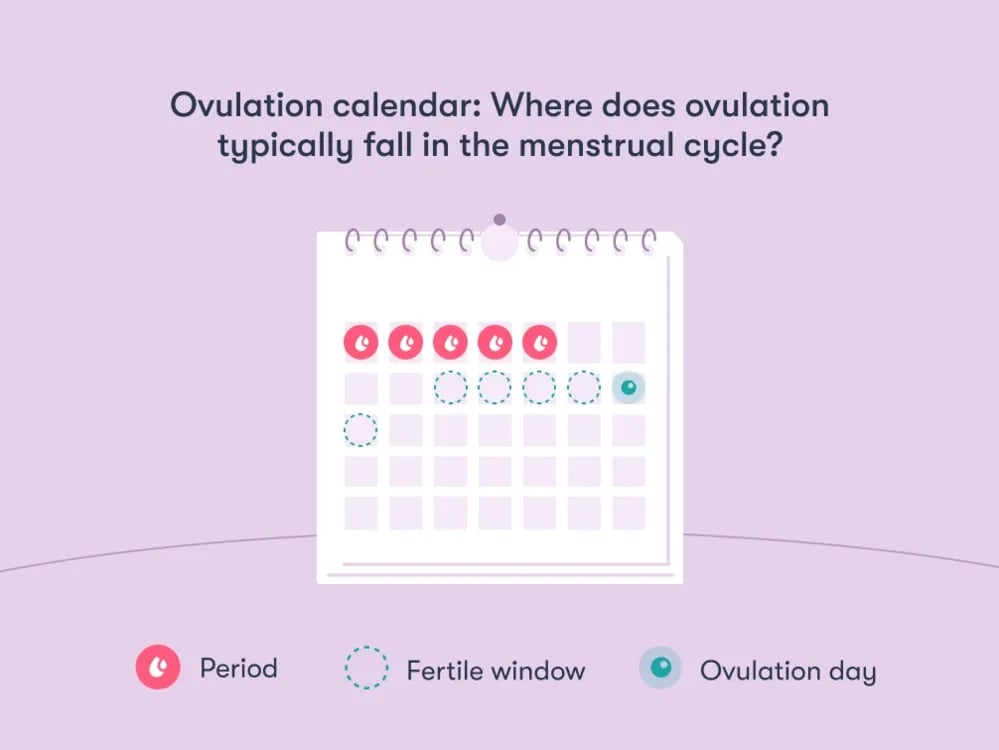-
Tracking cycle
-
Getting pregnant
-
Pregnancy
-
Help Center
-
Flo for Partners
-
Anonymous Mode
-
Flo app reviews
-
Flo Premium New
-
Secret Chats New
-
Symptom Checker New
-
Your cycle
-
Health 360°
-
Getting pregnant
-
Pregnancy
-
Being a mom
-
LGBTQ+
-
Quizzes
-
Ovulation calculator
-
hCG calculator
-
Pregnancy test calculator
-
Menstrual cycle calculator
-
Period calculator
-
Implantation calculator
-
Pregnancy weeks to months calculator
-
Pregnancy due date calculator
-
IVF and FET due date calculator
-
Due date calculator by ultrasound
-
Medical Affairs
-
Science & Research
-
Pass It On Project New
-
Privacy Portal
-
Press Center
-
Flo Accuracy
-
Careers
-
Contact Us
Ovulation calculator: Figure out your most fertile days
Knowing when you ovulate helps you better understand your fertile window (and when you have a high chance of getting pregnant). Find out when that might be with Flo’s easy-to-use ovulation calculator.



Your Flo membership is now active
To start your journey:- 1. Download the Flo app.
- 2. Log in to your account.
- Remember that ovulation predictors and calculators can help you learn more about your cycle and fertile window, but they are for informational purposes only. They cannot and should not be used to prevent pregnancy or as a conception aid. Menstrual cycles are different from person to person and can vary from month to month. Results are estimates only, and actual ovulation will vary.
- Please note that Flo Health does not collect, process, or store any of the data that you enter while using these tools. All calculations are done exclusively in your browser. Flo Health does not have access to the results. All data will be permanently erased after leaving or closing the page.
Learn more with Flo!

If you’re trying to get pregnant, it pays to know what ovulation is and when it might happen for you. This is the big event each cycle when one of your ovaries releases an egg and is when you’re most fertile. We only have a small fertile window each month during which we can conceive, so if you’re trying, it’s handy to know when this is for you.
By using some basic information about your cycle, such as the first day of your last period, Flo’s ovulation calculator can predict when you might ovulate, so you know your most fertile days. Here’s everything you need to know.
Key takeaways on calculating your fertile window
- Knowing when you ovulate helps you identify your fertile window and, therefore, the best time to have sex to get pregnant. Ovulation calculators use one set of your cycle dates and can help you figure out your time of ovulation.
- If you’d like even more accurate predictions for when you might be in your fertile window, you can download an app like Flo.
- While the average menstrual cycle is considered to be 28 days, and ovulation generally happens midway through or around day 14, this isn’t the case for everyone. If yours is between 21 to 35 days, then it’s still considered to be typical.
- There are signs of ovulation to know, such as changes to your cervical mucus and a slight increase in your basal body temperature (BBT, your natural temperature when you’re resting).
- Some people also say they feel cramps, breast tenderness, and increased sexual desire at this point in their cycle.
How are your fertile days calculated in the ovulation calculator?
Once you’ve decided that you’d like to start a family, it’s natural to want to do all you can to maximize your chances of conceiving. One way you might do this is by ovulation tracking and using an ovulation calculator to establish when you’re most likely to conceive during your cycle.
Firstly, ovulation is the point in your cycle when your body releases an egg to be potentially fertilized by a sperm. Once it’s been released, your egg will travel down one of your fallopian tubes, and for the next 12 to 24 hours, it’s what doctors call “viable” or able to be fertilized. If you have sex during this time, then you might become pregnant.
A wild fertility fact is sperm can live in your body for up to five days after sex. That means your fertile window spans around six days in total: the five days before ovulation plus one day after.
Having lots of sex around ovulation can indeed boost your chances of getting pregnant. And using an ovulation calculator can help you time this.
Since your time of ovulation can change from cycle to cycle to cycle, Flo can’t give you an exact day of ovulation. However, using the first day of your last period and your average cycle length, Flo can help you predict the window of when you might ovulate.
“The standard for ovulation time is midway through your cycle,” explains obstetrician and gynecologist Dr. Charlsie Celestine, New Jersey, US. “So a 28-day cycle generally ovulates on day 14. However, if your cycle is longer or shorter, then this midpoint date fluctuates along with that. For example, a 21-day cycle might ovulate on day 10 or 11.”
What’s the average length of a menstrual cycle?
When it comes to our menstrual cycles, it can be tough to make generalized predictions. Everyone is slightly different. The average cycle length is considered to be about 28 days. However, research shows this textbook 28-day cycle isn’t the case for most people.
Normal menstrual cycles can range from every 21 days to every 35 days. The time between ovulation and your next period will usually be about 14 to 16 days, though. Again, this can slightly differ. Sometimes, you might experience early ovulation, for example. Using a cycle-tracking app like Flo can help you understand what your normal is.

What are the signs of ovulation?
There are lots of ways to track ovulation. You can use an app like Flo, and your body also gives off subtle signs of ovulation. Some people prefer to monitor body signs as well as using ovulation tests. These can include:
- A change to your cervical mucus: One sign that ovulation is happening soon is a change in your vaginal discharge (cervical mucus). This discharge may be different from what you might usually see in your underwear; it could be clear and have a thinner, more slippery consistency, similar to raw egg whites.
- Increase in basal body temperature: After ovulation, you might also experience a small rise in your BBT. This is the temperature of your body when you’re resting. It may rise by around 0.5ºF (0.3ºC). We aren’t expecting you to notice this without a little help. You may be able to notice the change on a digital BBT thermometer if you consistently track your temperature around the same time each day, preferably first thing in the morning.
- Changes to your cervix: Examining your own cervix can be tricky, so before we dive into this, know that checking changes to your cervix isn’t recommended if you’re monitoring ovulation. Checking your BBT and tracking changes to your discharge can be much easier. However, if you’d like to get to know your body better, then it’s handy to know that your cervix changes in texture and position during your cycle. You might notice that during ovulation, it will be higher and feel soft. You’ll also notice that after ovulation is over, it becomes much harder again.
You can think of the changes to your cervical mucus as a big sign that ovulation is about to happen, and changes to your BBT mean that you’ve just ovulated. However, some people report feeling different symptoms, which can mimic how you feel just before your period starts. They include:
- Cramps
- Breast tenderness
- Changes to your sex drive
- Bloating
Can ovulation tracking increase your chances of pregnancy?
Ovulation tracking can increase your chances of pregnancy by helping you identify your fertile window — the days when you are most likely to conceive. Research suggests that couples who have sex one to two days before ovulation are most likely to conceive.
But ovulation tracking using dates or apps isn’t foolproof, explains Dr. Celestine, as your cycle length can change from month to month.
“The best way to track it yourself would be an ovulation predictor kit where you urinate on a stick, similar to a pregnancy test,” she reveals. They measure levels of a hormone called luteinizing hormone (LH) in your urine, as this surges right before you ovulate.
The surge in LH happens on average around 36 hours before ovulation, so start testing two or three days before the ovulation calculator says you’re likely to ovulate. It’s a good idea to track your ovulation over two or three months using ovulation tests, explains Dr. Celestine, to give you useful data to show a health care professional.
“If there’s no ovulation at all in this time, or if you are getting positive ovulation results but have been trying to get pregnant for over a year (if you’re under 35) or six months (if you’re over 35), then see your doctor.” If you have an irregular cycle or have a condition like polycystic ovary syndrome (PCOS), the results from ovulation predictor kits may not be accurate or helpful, so reach out to your doctor.
Learn more with Flo!
Frequently asked questions about the ovulation calculator
Is the ovulation calculator 100% accurate?
Ovulation calculators, including Flo’s, aren’t 100% accurate. They estimate your fertile window from the average length of your menstrual cycle and the assumption that ovulation occurs about 14 days before your next period. But a few factors can affect their accuracy, such as cycle variability and external factors like stress or medications, which can affect the timing of ovulation.
Is there an ovulation calculator for irregular cycles?
Tracking ovulation with irregular periods can be tough. If you have irregular cycles, estimating ovulation using a calculator that relies on period dates can be a little trickier than for people with clockwork periods. If you experience recurring irregular cycles or skipped cycles or have a condition like PCOS, the results from ovulation predictor kits may not be accurate or helpful, so reach out to your doctor.
An app like Flo can help you spot patterns in your cycles and give you clues as to when ovulation is likely to occur. If you have more regular cycles, then ovulation-tracking kits can help too. They can identify the specific change in LH hormone that triggers ovulation.
References
“Basal Body Temperature.” Cleveland Clinic, my.clevelandclinic.org/health/articles/21065-basal-body-temperature. Accessed 1 Nov. 2024.
“Basal Body Temperature for Natural Family Planning.” Mayo Clinic, 10 Feb. 2023, www.mayoclinic.org/tests-procedures/basal-body-temperature/about/pac-20393026.
“Cervical Mucus.” Cleveland Clinic, my.clevelandclinic.org/health/body/21957-cervical-mucus. Accessed 1 Nov. 2024.
“Cervix.” Cleveland Clinic, my.clevelandclinic.org/health/body/23279-cervix. Accessed 1 Nov. 2024.
Faust, Louis, et al. “Findings from a Mobile Application-Based Cohort Are Consistent with Established Knowledge of the Menstrual Cycle, Fertile Window, and Conception.” Fertility and Sterility, vol. 112, no. 3, Sep. 2019, pp. 450–57, https://doi.org/10.1016/j.fertnstert.2019.05.008.
“Follicular Phase.” Cleveland Clinic, my.clevelandclinic.org/health/body/23953-follicular-phase. Accessed 1 Nov. 2024.
“Pregnancy: Identifying Fertile Days.” MedlinePlus, medlineplus.gov/ency/article/007015.htm. Accessed 1 Nov. 2024.
“Luteinizing Hormone.” Cleveland Clinic, my.clevelandclinic.org/health/body/22255-luteinizing-hormone. Accessed 1 Nov. 2024.
“Menstrual Cycle.” Cleveland Clinic, my.clevelandclinic.org/health/articles/10132-menstrual-cycle. Accessed 1 Nov. 2024.
“Ovulation.” Cleveland Clinic, my.clevelandclinic.org/health/articles/23439-ovulation. Accessed 1 Nov. 2024.
“Period Irregularities to Get Checked Out.” Mayo Clinic, www.mayoclinic.org/healthy-lifestyle/womens-health/in-depth/menstrual-cycle/art-20047186. Accessed 1 Nov. 2024.
“Signs You’re Ovulating (besides Taking a Test).” Mayo Clinic, www.mayoclinic.org/healthy-lifestyle/getting-pregnant/expert-answers/ovulation-signs/faq-20058000. Accessed 1 Nov. 2024.
“Sperm: How Long Do They Live after Ejaculation?” Mayo Clinic, www.mayoclinic.org/healthy-lifestyle/getting-pregnant/expert-answers/pregnancy/faq-20058504. Accessed 1 Nov. 2024.
Su, Hsiu-Wei, et al. “Detection of Ovulation, a Review of Currently Available Methods.” Bioengineering & Translational Medicine, vol. 2, no. 3, Sept. 2017, pp. 238–246.
“Trying to Get Pregnant? Here’s When to Have Sex.” American College of Obstetricians and Gynecologists, www.acog.org/womens-health/experts-and-stories/the-latest/trying-to-get-pregnant-heres-when-to-have-sex. Accessed 1 Nov. 2024.